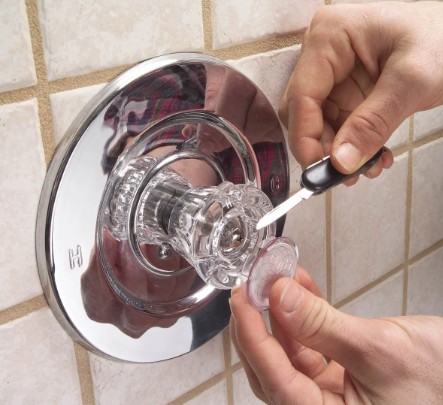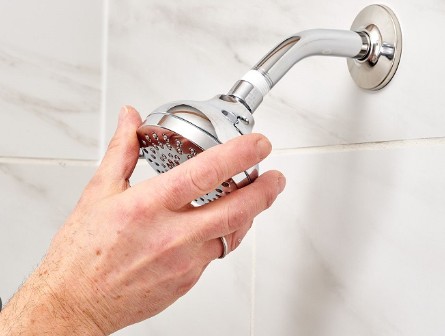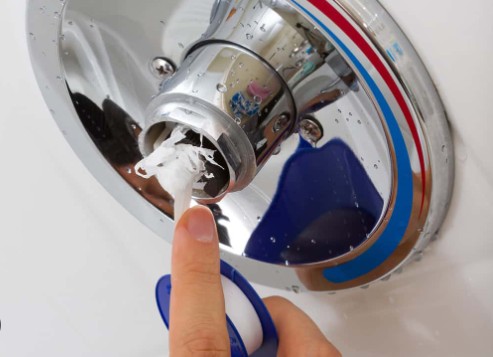The constant dripping from a leaking shower faucet not only leads to water wastage but can also drive up your water bill and is annoying. So, let’s learn how to fix a leaky shower faucet single handle so you can save money and water and avoid the frustration of a constantly dripping shower faucet.
Your single-handle shower faucet is leaking because of a worn-out cartridge or valve, loose or damaged O-ring or seals, corrosion, or mineral buildup. Other causes include normal wear and tear, high water pressure, improper installation, and a damaged faucet body.
You can fix your leaking single-handle shower faucet with a simple DIY project, basic tools, and patience. Keep reading for a comprehensive guide.

How To Fix A Leaky Shower Faucet Single Handle (Causes of Leaking & Fixes)
| Problem | Possible Causes | Recommended Fixes | |
| 1. | Damaged Cartridge or Valve | Damaged seals Wear and tear from repeated use Sediment or debris accumulation Using the wrong type or size of cartridge or valve Damaged valve stem or spindle Cracked valve or cartridge body | Repair the damaged seals, components, or valve body Replace the valve or cartridge |
| 2. | Worn-Out Washers | Deterioration due to regular use and water exposure | Install a new washer |
| 3. | O-ring Problems | Deteriorated O-ring Improper installation Loose or improperly seated O-ring O-ring size or type mismatch Sediment buildup | Replace your current O-ring with a new one Ensure the O-ring is installed properly |
| 4. | Loose or Damaged Parts | Loose handle, cartridge, or valve assembly Damaged cartridge or valve components Loose or damaged packing nut Worn-out seals or gasket | Tighten loose parts Replace any damaged parts |
| 5. | Corrosion Or Mineral Buildup | Mineral buildup in the valve, cartridge, or faucet spout Minerals corroding metal parts | Clean the affected parts to remove the mineral deposits |
| 6. | High Water Pressure | High water pressure accelerates wear and tear or loosens fittings and connections. | Fix the damaged parts Regulate your water pressure with a pressure-reducing valve |
| 7. | Temperature Fluctuations | Components wear and tear due to frequent and extreme water temperature fluctuations Rapid temperature changes stressing the cartridge or valve Deterioration of shower faucet’s internal parts from thermal cycling | Adjust your shower faucet’s temperature limit Upgrade your shower faucet to a thermostatic valve Regular shower faucet maintenance Replace the damaged parts |
1. Worn Out Cartridge or Valve
Modern shower faucets often use cartridges or valves to control water flow and temperature. Your shower faucet will likely leak if these parts get damaged.
Cartridges and valves contain seals or gaskets designed to create a waterproof seal when the faucet is in the closed position. However, these seals can wear out or become damaged, allowing water to leak even when the faucet is turned off.
Repeated use can also cause the internal components of a cartridge or valve to wear down as it leads to gaps or cracks in the valve, resulting in water leakage.
Furthermore, sediment or debris in the water supply can accumulate in the cartridge or valve, hindering its ability to function correctly. This buildup can prevent the valve from fully closing, leading to leaks.
Moreover, the valve stem or spindle can be damaged, leading to leaks. In addition, physical damage to the cartridge or valve body, such as cracks or fractures, can create pathways for water to escape, causing leaks.
Also, perhaps you installed the wrong size or type of cartridge or valve. Such a valve or cartridge will not fit properly or function as intended, resulting in leaks.
Fix
Replace the cartridge or valve. The RP46074 Shower Valve Cartridge Assembly (View On Amazon) is easy to install and can repair a leaking faucet. It is suitable for all single-handle 13/14 series bathtub/shower.
Repair any damaged seals, components, or the valve body.
2. Worn-Out Washers
Washers are small rubber or plastic components located inside the faucet handle that forms a watertight seal when you turn off the faucet. Regular exposure to water and use can make these washers deteriorate or become damaged, leading to leaks.
Fix
Disassemble your single-handle shower faucet, access the affected washer, and then replace it with a new one.
3. O-ring Problems
O-rings are rubber or silicone gaskets that provide a seal between a faucet’s moving parts. However, O-rings can deteriorate or become damaged, leading to leaks, especially if exposed to harsh water conditions or if you use the faucet frequently.
Additionally, the O-ring won’t provide a proper seal if you didn’t install it correctly during faucet assembly or maintenance, resulting in leaks. Furthermore, water will pass through gaps if the O-ring is loose or not properly seated.
Leaks can also stem from using the wrong size or type of O-ring. In addition, sediments can cause the O-ring to lose its sealing ability, resulting in leaks around your faucet handle.
Fix
Inspect the O-ring for signs of wear, damage, or deformation. If you notice any issues, remove the old O-ring, then replace it with one of the same size and type, ensuring it fits snugly and is properly seated.

4. Loose or Damaged Parts
Damages within the faucet assembly could be the reason your single-handle shower faucet leaks.
Vibrations or regular use can make the handle of your single-handle shower faucet loose. If the handle is not tightly secured, it may not correctly close the internal valve, allowing water to leak.
If this cartridge or valve assembly can create gaps in the sealing mechanism, it becomes loose, leading to leaks. Moreover, the internal components of the cartridge or valve, such as the seals, O-rings, or gaskets, can become damaged or worn out, affecting their ability to create a proper seal, resulting in leaks.
The packing nut will also allow water to escape around the valve stem if loose or damaged, leading to leaks. The seals and gaskets can also degrade, become worn, or get damaged.
Fix
- Check for loose parts and tighten them.
- Examine the cartridge or valve assembly, seals, O-rings, gaskets, and packing nuts for damage or wear. Replace any damaged or worn parts.
5. Corrosion Or Mineral Buildup
Another potential cause of a leaky single-handle shower faucet is corrosion and mineral buildup, which is especially common in areas with hard water. Over time, these minerals can accumulate in the faucet components, leading to corrosion and blockages that can result in leaks.
Mineral deposits can accumulate inside the valve or cartridge assembly, obstructing the movement of internal components, leading to improper sealing and, consequently, leaks. Additionally, minerals in the water can react with your faucet’s metal components, leading to corrosion.
Minerals can also accumulate inside the faucet spout, hindering the proper closure of the spout. This can result in water continuing to flow even when the faucet is turned off, causing a leak.
Fix
Use a mixture of white vinegar and water or a commercial mineral deposit remover to dissolve and remove the mineral buildup. Soak the affected parts or scrub them if necessary to thoroughly clean them.
6. High Water Pressure
High water pressure exerts a greater force on the internal components of a single-handle shower faucet, including the valve or cartridge. The heightened stress can expedite the process of wear and tear, causing the seals, O-rings, and gaskets to deteriorate more quickly.
In addition, over time, the excessive force from high water pressure can damage the valve or cartridge inside the faucet. This damage can result in the inability to create a proper seal, allowing water to leak.
Furthermore, high water pressure can loosen your plumbing system’s fittings and connections. This can result in water escaping through gaps or joints, including those in the shower faucet assembly.
Fix
a) Measure Water Pressure
Determine the water pressure with a gauge. Over 80psi is considered high and would need to be lowered.
b) Install A Pressure-Reducing Valve
If the water pressure is consistently high, install a pressure-reducing valve (PRV) near the main water supply to regulate the pressure. A PRV can help reduce the stress on your plumbing fixtures, including the shower faucet, and prevent leaks caused by high pressure.
c) Monitor And Maintain
Regularly monitor the water pressure in your plumbing system and maintain the PRV if you have one installed. Periodic checks and adjustments can help ensure that water pressure remains within a safe range and does not cause damage to your faucet.
d) Address Any Existing Damage
If your shower faucet is already leaking due to high water pressure, replace the damaged components.

7. Temperature Fluctuations
When you experience frequent and extreme temperature fluctuations in your shower water, the faucet components can expand and contract repeatedly. This expansion and contraction can cause wear and tear on the internal seals, O-rings, and gaskets, leading to leaks.
Also, rapid temperature changes can stress the valve or cartridge inside the faucet. Over time, this stress can lead to damage to these components, undermining their capacity to establish an effective seal.
In addition, repeatedly turning the faucet from hot to cold and vice versa can contribute to the wear and deterioration of your faucet’s internal parts. This can lead to the formation of gaps or cracks, allowing water to escape.
Fix
i) Check The Faucet’s Temperature Limit
Some single-handle shower faucets have a temperature limit stop that allows you to control the maximum hot water temperature. Adjust this setting to reduce extreme temperature fluctuations and, in turn, reduce stress on your shower faucet components.
ii) Install A Thermostatic Valve
Consider upgrading your shower faucet to include a pressure-balancing valve. This valve helps maintain a steady water temperature, even when the hot or cold water supply fluctuates.
It can also protect against sudden scalding or cold water shocks.
iii) Regular Maintenance
Perform regular maintenance on your faucet, including inspecting and replacing worn seals, O-rings, and gaskets as needed. This can help prevent leaks caused by temperature-related wear and tear.
iv) Avoid Rapid Temperature Changes
Exercise caution when adjusting the water temperature rapidly during your shower. Opt for gradual adjustments because they will help reduce stress on the faucet components.
v) Replace Damaged Parts
If your faucet is already leaking due to temperature fluctuations, replace the damaged components.
Summary of How To Fix A Leaky Shower Faucet Single Handle
Fix your leaky single-handle shower faucet to enjoy a leak-free shower again. Fortunately, you can address the causes of this problem yourself. However, remember to turn off the water supply, use the correct replacement parts, and be patient.
Also, Read:
